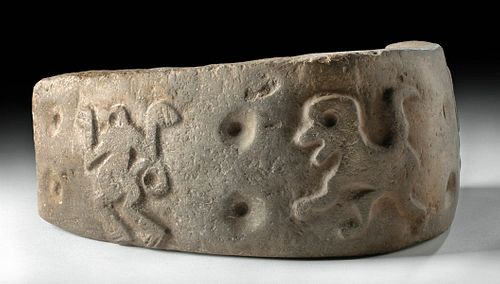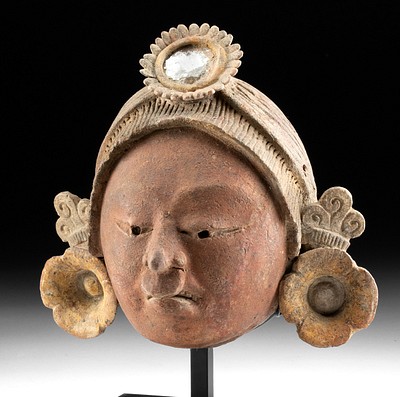Rare Veracruz Ballgame-used Stone Yoke w/ Monkeys
Lot 130a
About Seller
Artemis Gallery
686 S Taylor Ave, Ste 106
Louisville, CO 80027
United States
Selling antiquities, ancient and ethnographic art online since 1993, Artemis Gallery specializes in Classical Antiquities (Egyptian, Greek, Roman, Near Eastern), Asian, Pre-Columbian, African / Tribal / Oceanographic art. Our extensive inventory includes pottery, stone, metal, wood, glass and textil...Read more
Categories
Estimate:
$4,000 - $6,000
Absentee vs Live bid
Two ways to bid:
- Leave a max absentee bid and the platform will bid on your behalf up to your maximum bid during the live auction.
- Bid live during the auction and your bids will be submitted real-time to the auctioneer.
Bid Increments
| Price | Bid Increment |
|---|---|
| $0 | $25 |
| $300 | $50 |
| $1,000 | $100 |
| $2,000 | $250 |
| $5,000 | $500 |
| $10,000 | $1,000 |
| $20,000 | $2,500 |
| $50,000 | $5,000 |
| $100,000 | $10,000 |
| $200,000 | $20,000 |
About Auction
By Artemis Gallery
Jul 14, 2022
Set Reminder
2022-07-14 10:00:00
2022-07-14 10:00:00
America/New_York
Bidsquare
Bidsquare : Exceptional Antiquities Ethnographica Fine Art
https://www.bidsquare.com/auctions/artemis-gallery/exceptional-antiquities-ethnographica-fine-art-9692
Museum-worthy examples of classical antiquities (Egyptian, Greek, Roman, Near Eastern), Viking, Far East / Asian, Pre-Columbian, African / Tribal, Oceanic, Native American, Spanish Colonial, Fossils, Ancient Jewelry, Fine / Visual Arts, so much more! Artemis Gallery info@artemisgallery.com
Museum-worthy examples of classical antiquities (Egyptian, Greek, Roman, Near Eastern), Viking, Far East / Asian, Pre-Columbian, African / Tribal, Oceanic, Native American, Spanish Colonial, Fossils, Ancient Jewelry, Fine / Visual Arts, so much more! Artemis Gallery info@artemisgallery.com
- Lot Description
Pre-Columbian, Mexico, Vera Cruz, ca. 400 to 700 CE. A superb stone yoke representing the protective U-shaped guards worn around the waist by Mesoamerican ballplayers and displaying the relief of 3 monkeys. The exterior of the band presents a trio of simian figures all facing left with the central animal appearing as though running and the other 2 holding up both arms in a position reminiscent of dancing. Each creature exhibits a domed head, a sizeable eye, a projecting snout, an open mouth, bent limbs, and curved tails. A pair of annular indentations separates the figures from one another and adorns the terminals of the yoke. Yokes made of perishable materials such as quilted cotton and wood have been preserved only in visual depictions in paintings and sculptures, making stone yokes like this one, worn at opening and closing ceremonies, awarded as trophies, and placed in tombs, even more special and prized. Size: 8.9" L x 3.8" W (22.6 cm x 9.7 cm)
The Pre-Columbian ballgame originated in the first millennium BCE, most likely in the Valley of Mexico, and was regarded as not merely an athletic activity but rather as a ceremonial means of controlling or predicting the future. The ancients of Mesoamerica played ballgames in a sacred ballcourt space. Some cultures expected players to dedicate themselves to practicing the game and preparing for matches; however, other cultures forced war captives to play the game and sacrificed the losing team. Another custom involved using the possessions of onlookers as prizes for the victorious team.
Ceremonial stone yokes have been found concentrated at all of the major sites of Mayan games, such as Chichen Itza, a major pre-Colombian site which includes a large rectangular ball court of lush green grass, surrounded by a stone amphitheater for spectators. The prevailing theory about the yokes' purpose is that they were worn as belts by the athletes and used as a part of the game, perhaps as a surface upon which the athletes bounced the ball. The athletes may have worn wooden yokes, and the stone examples were likely ceremonial yokes. This theory is based upon the discovery of stone effigy figurines of Mayan athletes that consistently depict the athletes dressed in full ceremonial gear - including these U-shaped yokes, which are always situated around the waists of the athletes. These sculpted figurines often depict the yokes with representations of leather or fabric around the body to show how the yokes are held in place around the athlete's waists.
Provenance: ex-private Bishop Family Trust collection, the Trust of the late Bill Bishop, a noted antiquarian with shops in Scottsdale, Arizona and Allenspark, Colorado, USA, acquired before 2010
All items legal to buy/sell under U.S. Statute covering cultural patrimony Code 2600, CHAPTER 14, and are guaranteed to be as described or your money back.
A Certificate of Authenticity will accompany all winning bids.
PLEASE NOTE: Due to recent increases of shipments being seized by Australian & German customs (even for items with pre-UNESCO provenance), we will no longer ship most antiquities and ancient Chinese art to Australia & Germany. For categories of items that are acceptable to ship to Australia or Germany, please contact us directly or work with your local customs brokerage firm.
Display stands not described as included/custom in the item description are for photography purposes only and will not be included with the item upon shipping.
#172884Expected nicks, chips and scratches, commensurate with age. Otherwise, intact and excellent with nice remaining detail.Condition
- Shipping Info
-
All shipping is handled in-house for your convenience. Your invoice from Artemis Gallery will include shipping calculation instructions. If in doubt, please inquire BEFORE bidding for estimated shipping costs for individual items.
-
- Buyer's Premium



 EUR
EUR CAD
CAD AUD
AUD GBP
GBP MXN
MXN HKD
HKD CNY
CNY MYR
MYR SEK
SEK SGD
SGD CHF
CHF THB
THB














